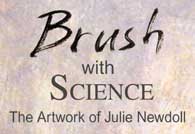

 View Portfolio |
 Inside Time |
 Shows |
 About/Contact the Artist |
New Works
Branching into new territories and finishing up continuing series.
The transportation of Ra through a Vault Protein out of the Night Sky and into the Birth of the Sunrise, 33" x 44", 2001.
Private Collection (sold). Prints available.
In the ancient Egyptian legend, “The Regions of Night and Thick Darkness”, Ra, the sun king, dies each night and makes a journey in his “Boat of Millions of Years” through the otherworld of the night sky. After traveling through twelve regions of the underworld country, Duat, each guarded by a gate and a terrifying snake, he is once again reunited with his soul in the form of the scarab beetle, Khepera. The sun king is thus alive again, and a new sunrise is born.
This mysterious process of daily transport to create the cycle of night and day is shown here inside of a capsule-like particle composed of proteins called “the vault”. The function of the vault particle is still a scientific mystery, although there is some evidence that it is involved in cellular transport. The structure of the vault is a “hollow, barrel-like structure with two protruding caps and an invaginated waist”. In this painting we are inside of a vault particle looking out through one of its end caps. At the caps of the structure there are 12 RNA strands of a very special type, similar to the telomeres at the endcaps of chromosomes (pieces of DNA which help protect the chromosome and keep the ends from fraying). The night sky was considered a vault by ancient peoples that did not realize the earth was round.
This story may be found in “Legends of Ancient Egypt”, by M.A.Murray, Dover Publications, Inc., 2000, ISBN 0-486-41137-0. Inspired by the papers “Structure of the vault, a ubiquitous cellular component”, Lawrence B Kong , Amara C Siva , Leonard H Rome and Phoebe L Stewart , Structure 1999, Vol 7 No 4; and “RNA location and modeling of a WD40 repeat domain within the vault”, Lawrence B. Kong, Amara C. Siva, Valerie A. Kickhoefer, Leonard H. Rome, and Phoebe L. Stewart , RNA(2000), 6:890–900+
Sense of Smell Triptych: For Every Scent, a Pattern, 10" x 10", 2001, Private Collection (sold). Prints available
Our noses have a field of about 1000 different types of smell receptors, yet we can smell about 10,000 scents. Each scent may stick to more than one kind of receptor, as different areas of the scent molecule may be able to attach to a different kind of receptor. Via these receptors and the neurons that transfer their information to the glomeruli of the brain, each scent forms a particular pattern that the brain interprets as a particular scent. The arrangement of glomeruli in each species is the same, so that we all smell the same scent when smelling the same things.
Represented in these three panels, three different flowers have formed their particular pattern identifying them to the brain as a specific type of flower. A sea of olfactory neurons flows in the foreground, with cliffs of respiratory mucosa in the background, breathing in to gather the scents for the olfactory mucosa in the midground.
Inspired in part by "Visualizing an Olfactory Sensory Map", by Mombaerts P, Wang F, Dulac C, Chao SK, Nemes A, Mendelsohn M, Edmondson J, Axel R., Cell. 1996 Nov 15;87(4):675-86, and the review "The Molecular Logic of Smell", by Axel R., Sci Am. 1995 Oct;273(4):154-9. Other visual reference also from "The fine structure of the olfactory mucosa in man", by Moran DT, Rowley JC 3d, Jafek BW, Lovell MA, J Neurocytol. 1982 Oct;11(5):721-46; and "Three-dimensional scanning electron microscopic study of the normal hamster olfactory epithelium" by Richard M. Costanzo and Edward E. Morrison, Journal of Neurocytology 18, 381-391 (1989).
Superoxide Dismutase Fountain of Youth Number Two, 33" x 44", Available for purchase.Prints available, 2001, (temporary digital photo of painting, click for larger image)
In the scientific search for extension of the human life span, one technique involves mimicking the action of the enzyme superoxide dismutase. This enzyme traps harmful byproducts of metabolism and turns them into harmless oxygen and water. As humans age, this enzyme is not produced in as great a quantity, leaving tissues and genetic material vulnerable to the toxic products of metabolism. A drug was invented which mimics the action of superoxide dismutase (EUK-8 and EUK-134) and tested on the worm Caenorhabditis elegans. The life span of the worm was indeed increased by about 54%. Much of this sort of metabolism takes place in the mitochondria.
This is the second in a fountain of youth series. The fountain depicts a female statue sitting in a mitochondria, holding the horn of a Unicorn to symbolize superoxide dismutase. The Unicorn horn was thought to have the power to turn poisons into water. Here it is pouring out its product of air and water to create the fountain.
Inspired by the paper "Extension of Life-Span with Superoxide Dismutase/Catalase Mimetics", by Simon Melov, 1 Joanne Ravenscroft, 2 * Sarwatt Malik, 2, Matt S. Gill, 2 David W. Walker, 2 † Peter E. Clayton, 2, Douglas C. Wallace, 3 Bernard Malfroy, 4 Susan R. Doctrow, 4, Gordon J. Lithgow 2
1 Buck Institute for Age Research, Novato, CA 94949, USA. 2 The School of Biological Sciences and the Academic Unit of Child Health, The University of Manchester, Manchester, M13 9PT, UK. 3 Center for Molecular Medicine, Emory University, Atlanta, GA30322, USA. 4 Eukarion, Bedford, MA 01730, USA.